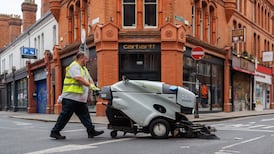The best way to get a glimpse of the private villas to which China's leaders retreat for the summer at Beidaihe is to climb up to the "sea-admiring pavilion" on the hills behind the Bohai Sea beach resort. From there you still can't see much more than a few orange roof tops among the foliage below, where the estates of the holidaying Communist Party chiefs take up a third of the area of the town.
But high among the pine and cypress trees of Lianfengshan Forest one government villa is accessible nowadays. It was once occupied by Lin Biao, a slight, heavy-browed revolutionary hero of the 1950s and 1960s.
If the condition of his decrepit two-storey villa is anything to go by, the Chinese party bosses are by no means living in luxury. The black-brick building has lain empty since Lin's death in an aircraft accident in Mongolia, but even in its heyday the atmosphere must have been pretty grim.
At one end there is a creepy garage-like chamber with a deep concrete pit which served as a swimming pool. In the main section, office-like rooms open off peeling, institutional corridors. The bedrooms are bare except for lumpy armchairs and bedsteads on which are propped handwritten notices forbidding photography.
One room has been turned into a black museum, with photographs of the charred bodies of the Lin family beside the plane wreckage in Mongolia, and a diatribe against the "clique" with which he surrounded himself. Lin Biao was a brilliant Red army general and the driving force behind the cult of Mao Zedong, but ended up allegedly plotting to kill him and seize power in 1971. Mao was tipped off and Lin fled from the villa, only to perish in the plane when it crashed due to lack of fuel.
Why this depressing, shoddy structure has been opened to visitors is a mystery. Deng Xiaoping's villa, which he inherited from Mao, also lies empty and would surely be much more interesting.
President Jiang Zemin would perhaps like to move into Deng's holiday home but that might be considered a bit presumptuous so soon after the paramount leader's death in February. In any event the new Chinese leader has his own villa in Beidaihe, as has Premier Li Peng and other senior party officials.
Holiday life for them is still apparently quite spartan. Their daily regime, from what a staff member revealed, is more like work than play. They get up at 6.30 a.m. to exercises, have breakfast and then visit each other for policy and personnel debates - which are much less bloody these days.
The Chinese leaders are never seen in the resort, which is a five-hour drive from Beijing and has been a watering spot for Chinese leaders since the Qing Dynasty. Each villa has a chef seconded from a Beijing hotel from July 5th to August 25th with instructions to provide four hot dishes and six cold dishes for main meals.
In communist times Beidaihe was used exclusively to reward model employees, soldiers and work units in its almost 200 sanitoria. The foreigners have come back with the opening-up policy. There were 20,000 non-Chinese tourists last year according to Liung Dianrong, director of Beidaihe Tourism Administration.
Chinese holiday-makers also come now in big numbers and stay in hotels or boarding houses where local peasants provide 74,000 beds. The sandy beaches are consequently crowded, and not cheap by Chinese standards. An umbrella and reclining bamboo chair costs the equivalent of £6. The life guards today wear Nike tee shirts and beach vendors sell iced Coke, but old habits, like Chinese public prudery, die hard. There are no bikinis on Beidaihe beach. Privately it's different. Men and women take showers (separately) in big barns, standing naked in long lines under ceiling taps which spurt out water when you step on a board underneath.
International bird watchers are also coming to Beidaihe in big numbers. Mr Liung told me that of more than 1,000 different species of birds in China, 405 have been seen in Beidaihe.
Indeed the compact area of hills, woods, inlets and creeks around the resort is well known to birders as the best site in the world for eastern Palearctic specialities. "Twitchers" coming to find rare birds are never disappointed.
I think maybe I should take up birding. There appears to be more chance of seeing a Chinese leaf warbler or a rare yellow-browed bunting in Beidaihe than a Jiang Zemin or a Li Peng.








